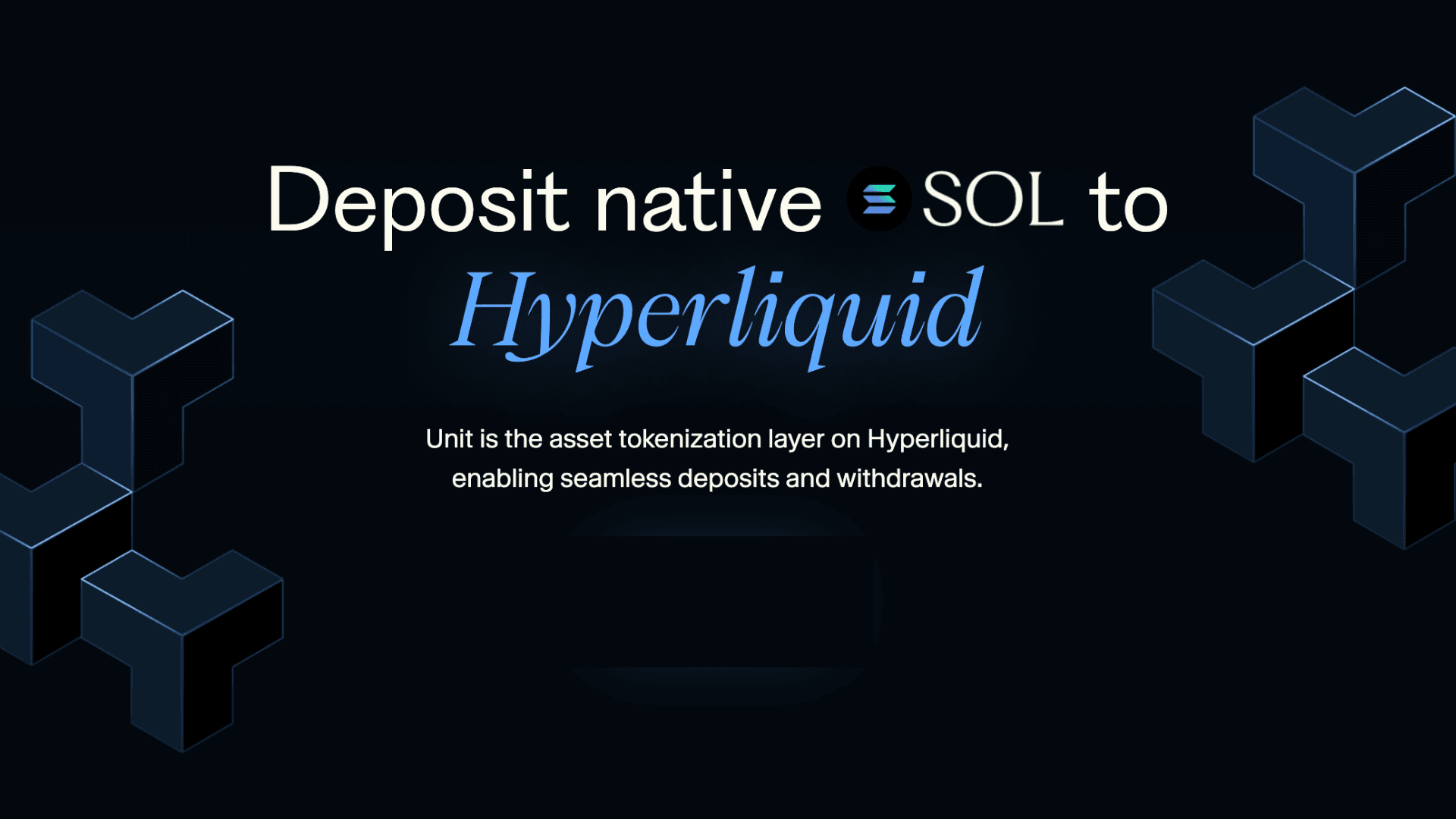Unit | Innovation in Hyperliquid Asset Movement
Duration
In Progress
Task
Supported Chains
Category
Unit | Innovation in Hyperliquid Asset Movement

Table of Contents
Deep Dive into Unit: The New Standard for Bringing BTC & ETH Securely & Seamlessly to Hyperliquid! What is Native Asset Tokenization Expanding DeFi Possibilities?
As the Hyperliquid ecosystem gains attention, we will explore one of its core technologies, "Unit," in an easy-to-understand manner for everyone from beginners to advanced users, delving into its appeal and future potential. Unit is an innovative protocol that enables major crypto assets like Bitcoin (BTC) and Ethereum (ETH) to be brought directly and securely onto the Hyperliquid platform in a way that overturns conventional methods. Let's unravel the entirety of Unit, which supports Hyperliquid's grand vision of "The House of All Finance." Furthermore, we will introduce what is currently known about the rumored $UNIT token airdrop.
1. What is Unit? Overview at a Glance and Benefits for You
What can you do with Unit?
Unit is a "decentralized asset tokenization protocol" designed exclusively for the Hyperliquid high-speed blockchain infrastructure. This might sound complicated, but in essence, it is a technology that allows you to bring your major crypto assets like Bitcoin (BTC), Ethereum (ETH), and Solana (SOL) directly and smoothly onto the Hyperliquid platform for use, without going through centralized exchanges (CEX) or conventional third-party bridges. Assets brought onto the platform are represented on Hyperliquid as "uBTC," "uETH," "uSOL," etc., forming the basis for spot trading and other activities.
Why is Unit important?
Unit is an indispensable part of the Hyperliquid ecosystem. It allows users to directly and securely deposit major crypto assets like BTC, ETH, and SOL from their respective native chains to Hyperliquid (as uBTC, uETH, uSOL) and also withdraw them.
The groundbreaking aspect of this mechanism is its ability to collectively avoid issues such as "custodial risk" associated with depositing assets in centralized exchanges (CEX) – like the risk of the custodian's bankruptcy or unauthorized access – and problems inherent in many third-party bridges, such as "complex mechanisms, security vulnerabilities, and reliance on unreliable synthetic assets (like wrapped tokens)."
Unit's security is protected by a decentralized "Guardian Network" that utilizes cutting-edge cryptographic technology called "MPC-TSS technology." This makes Unit a crucial strategic element for Hyperliquid to strengthen its spot market, achieve its grand vision of "The House of All Finance" in the future, and promote asset inflow into "HyperEVM," Hyperliquid's EVM-compatible environment.
Problems Unit Solves: What Was Wrong with Traditional Asset Movement?
One of the long-standing challenges in the crypto asset industry has been "securely and efficiently moving assets between different blockchains." Solving this challenge was crucial, especially for fully utilizing major assets like BTC, ETH, and SOL for trading and DeFi (Decentralized Finance) activities on high-performance decentralized exchanges (DEXs) like Hyperliquid.
Traditional methods and their problems:
- Via Centralized Exchanges (CEX):
- Problem: Requires depositing assets into a CEX, thus always entailing the CEX's own bankruptcy risk or hacking risk (custodial risk).
- Using Third-Party Bridge Protocols:
- Problem:
- Complex structure and potential security vulnerabilities: Large-scale hacking incidents have occurred in the past with Ronin Bridge, Nomad Bridge, and Wormhole Bridge.
- Dependency on synthetic assets: Deposited L1 assets are often converted into different "wrapped tokens," which carry the risk of price divergence (depeg risk) and the smart contract risk of the wrapping protocol itself [1].
- Problem:
Unit was developed to address these problems head-on. It provides a decentralized and "self-custodial" native tokenization layer where users retain control over their assets. Users deposit assets like BTC, ETH, and SOL directly into Hyperliquid and receive tokens on Hyperliquid with equivalent value to the original assets (uBTC, uETH, uSOL, respectively). This process aims to eliminate the need for centralized administrators and fundamentally avoid the risks associated with common synthetic asset bridges.
Unit aims to contribute to the realization of Hyperliquid's vision of "The House of All Finance." This means building a fully on-chain financial hub where users can complete all financial activities within the Hyperliquid ecosystem without relying on external bridges or exchanges. Unit strongly supports this vision by enabling even assets traditionally difficult to integrate into DeFi, like BTC, to be used on Hyperliquid in a reliable, self-custodial manner while maintaining a seamless user experience.
2. What Specifically Does Unit Do? Introduction to Project Activities
To achieve its objectives, the Unit project undertakes a wide range of development and service provision, as outlined below.
Core Service: Providing a Secure and Safe Asset Tokenization Layer
Unit's most fundamental activity is providing a decentralized asset tokenization layer for the Hyperliquid L1 blockchain. This enables users to:
- Direct Deposit: Directly deposit BTC, ETH, SOL, and even recently supported FARTCOIN, etc., from their personal wallets to Hyperliquid.
- Native Tokenization: Deposited assets are represented as native tokens on Hyperliquid (e.g., uBTC, uETH, uSOL) and become available for trading on Hyperliquid's spot order book and for use within the HyperEVM ecosystem.
- Free Utilization: Trade, transfer, or otherwise utilize these tokenized assets within the Hyperliquid platform.
- Easy Withdrawal: If necessary, directly withdraw these assets to a specified address on their respective native blockchains.
Continuous Development and Maintenance
Ongoing development activities are carried out to maintain and improve the stability and security of the Unit protocol. This includes the operation and refinement of the guardian network and agent software, which will be described later. Regular mainnet upgrades for feature enhancement and security improvement are also performed, with one such upgrade occurring on May 10, 2025 (UTC).
Collaboration and Partnerships for Ecosystem Expansion
Unit plays a crucial role within the Hyperliquid ecosystem and actively promotes collaboration with other protocols.
- Powering Hyperliquid's Spot Market: Unit is the foundational technology supporting Hyperliquid's spot market, demonstrating its importance by accounting for 35% of spot trading volume in March 2025.
- Gateway to HyperEVM: It enables cross-chain asset flows and functions as an entry point for introducing assets into HyperEVM (Hyperliquid's EVM-compatible environment).
- Strengthening Collaboration with DeFi Protocols:
- Partnership with Ethena Labs: Partnered with Ethena Labs to enhance the capital efficiency of assets bridged via Unit, such as uBTC, uETH, and uSOL. This allows users to borrow USDe using these Unit assets as collateral on platforms like Euler Finance, Felix Protocol, and Hyperdrive DeFi. This partnership adds immediate practical value to assets bridged with Unit, demonstrating that Unit is not just a bridge but an infrastructure closely integrated with the growth of the Hyperliquid ecosystem.
- Integration with Garden Finance: Integration with Garden Finance allows users to swap wBTC or cbBTC to uBTC on Hyperliquid with a single click.
- Realization of SPL20 Native Integration: Promoting the native integration of SPL20 tokens on Hyperliquid.
Transparent User Support and Communication
To ensure project transparency and user engagement, official documentation (docs.hyperunit.xyz) is provided, and active communication, including latest updates, announcements, and dialogue with the community, is conducted via X (formerly Twitter).
Since its mainnet launch in February 2025, Unit has rapidly expanded its utility and reach within the ecosystem through swift support for new assets like SOL and FARTCOIN, and integrations with Ethena and Garden Finance, demonstrating an agile development approach and a strong commitment to ecosystem expansion.
3. Technology Behind Unit: Why Is It Secure? A Clear Explanation of Its Mechanism
Unit is an advanced asset tokenization layer designed exclusively for the Hyperliquid L1 blockchain, employing a unique technological architecture that sets it apart from conventional bridge solutions. At its core are a "Guardian Network" focused on security and decentralization, and cutting-edge cryptographic technologies: "Multi-Party Computation (MPC)" and "Threshold Signature Scheme (TSS)."
Dedicated Design for Hyperliquid L1
Unit is not a generic solution but functions as a critical part of the Hyperliquid L1 architecture. Specifically, it handles the deposit and withdrawal of assets to the HyperCore network that powers the Hyperliquid DEX.
"Native Tokenization" is Key
One of Unit's most distinctive features is its "native tokenization" approach. This is neither custodian-based, where an administrator exists, nor reliant on synthetic assets (like wrapped tokens) whose value can be unstable. When a user deposits an asset from an external chain, like BTC, the Unit protocol verifies and signs this, directly issuing its "native equivalent" (e.g., uBTC) on Hyperliquid. This avoids the risks specific to synthetic assets that many bridges entail (peg instability or vulnerabilities in wrap/unwrap processes).
The Linchpin of Decentralized Security: Guardian Network and Agents
The operation and security of the Unit protocol are supported by a decentralized network of independent operators called "Guardians." Initial guardians include Unit itself, Hyperliquid, and Infinite Field.
- Role of Guardians: They function as "decentralized validators" that verify asset deposits off-chain, finalize transactions, and maintain the overall cryptographic consistency of the system.
- Agent Software: Each guardian runs "Agent" software developed by the Unit team, which enforces the rules and logic for cross-chain asset movement.
Key Components of an Agent
| Component | Primary Responsibility | Key Functions |
|---|---|---|
| Chain Service | Interacting with each blockchain, tracking deposits, confirming transaction finality, constructing/broadcasting payloads | Blockchain monitoring, on-chain activity verification, finality confirmation, transaction construction/submission |
| Flow Manager | Overseeing the multi-step state machine for cross-chain flows, enforcing protocol requirements and sequencing | State management, rule enforcement, operation sequencing, coordination of other components |
| Consensus Service | Executing agreement among guardians for critical operations (typically 2/3 quorum) | Quorum enforcement, consensus facilitation, proposal coordination by leader |
| Wallet Manager | Handling MPC-based key operations (executed within secure enclaves), storing encrypted private key shares, coordinating threshold signatures | Private key share management, MPC-TSS participation, threshold signature generation |
Ultimate Key Management: Multi-Party Computation (MPC) and Threshold Signature Scheme (TSS)
At the core of Unit's security model is the combination of MPC and TSS. For consensus on critical operations and key management, MPC-TSS, typically requiring approval from 2/3 or more of the total, is employed.
- Decentralized Key Generation and Storage: The private key required for transaction signing never exists in its complete form in any single location. The key is split among multiple guardians at generation, and each guardian stores an encrypted fragment (share) of the key within a "secure enclave" (e.g., Intel SGX, AWS Nitro – a secure execution environment isolated from the outside). This ensures that even if one guardian's environment is compromised, the confidentiality of the entire key is protected.
- Decentralized Signing: Signing transactions is done collaboratively by multiple guardians (at least the number set by the threshold). During this process, the complete private key is never reconstructed in memory. This eliminates single points of failure (where if one part fails, the whole system ceases to function) in key management and signing operations.
Other Key Security Measures
Unit employs multi-layered security measures beyond MPC/TSS.
- Deterministic State Machine: All protocol actions follow strict, verifiable workflows, ensuring processing consistency and mitigating risks of errors or malicious operations.
- Independent Guardian Checks: Each guardian independently verifies blockchain data, etc., before proceeding with transaction processing, reducing the risk of improper authorization.
- Rate Limiting: Protects the protocol from DoS attacks and similar threats.
- Collective Circuit Breaker: Temporarily halts the system if problems occur, preventing further damage.
- Others: A wide range of measures are in place, including hash-based configuration verification, secure public key distribution, manual deployment verification, comprehensive operational logging, and decentralized infrastructure.
Commitment to Regulatory Compliance
- Screening via matching against the OFAC (Office of Foreign Assets Control) list
- IP address blocking from specific regions
- Design considerations to avoid being classified as a money mixer or synthetic asset issuer
Unit's security model heavily relies on the integrity and operational security of a small set of permissioned guardians and advanced cryptographic techniques. While this represents a degree of centralization in its initial stages, plans for expanding the guardian network and opening up governance indicate a path towards greater decentralization.
This "native tokenization" approach directly avoids the vulnerability risks of wrapped tokens seen in past bridge hacks (e.g., Wormhole). Furthermore, the deterministic state machine and robust logging create high auditability and verifiability, which are crucial factors for building user trust and attracting institutional investors.
4. Unit's Amazing Points! Strengths and Uniqueness That Set It Apart
Unit possesses clear strengths and uniqueness compared to traditional cross-chain bridges.
- Native Tokenization vs. Synthetic Assets/Wrapping:
- Unit's Strength: Generates "native equivalents" of assets (e.g., uBTC) on Hyperliquid. Avoids risks specific to synthetic assets (depegging, smart contract vulnerabilities) and improves reliability.
- Self-Custodial vs. Custodian-Based:
- Unit's Strength: Users always maintain control of their own assets (non-custodial). Mitigates counterparty risk associated with centralized custodians. Designed to avoid risks like the Ronin Bridge incident.
- Decentralized Verification (MPC/TSS) vs. Vulnerable Multisig:
- Unit's Strength: Uses a decentralized guardian network employing MPC/TSS for transaction verification and signing. Since the complete private key does not exist in a single location, it offers higher security than traditional multisig and improved resistance to key leakage. This is a countermeasure against attacks like the Ronin Bridge hack.
- Deep Integration with the Hyperliquid Ecosystem:
- Unit's Strength: Built specifically for Hyperliquid and deeply integrated with HyperCore and HyperEVM. Realizes seamless UX and optimized performance, enabling new DeFi applications (portfolio margin, on-chain basis trades, etc.).
- Simple User Experience:
- Unit's Strength: Pursues simplicity like "send BTC to an address, and you're ready to trade." Lowers the barrier to entry for DeFi.
- High Traceability and Verifiability:
- Unit's Strength: Provides an immutable audit trail, enhancing transparency and accountability.
- Strategic Element for Realizing "The House of All Finance":
- Unit's Strength: Not just a utility, but a foundational pillar for Hyperliquid's grand vision. Continued development within the ecosystem can be expected.
Unit's architecture incorporates lessons learned from past bridge hacks. The elimination of single points of failure in private key management (MPC/TSS) and the avoidance of complexities associated with synthetic assets are major attractions for security-conscious users.
However, the small number of initial guardians means that the current level of decentralization is limited. But, future plans for network expansion and open governance suggest this point will be improved. Also, deep integration with Hyperliquid is a strength within the ecosystem, but it also means Unit's success is dependent on Hyperliquid's success.
5. Unit's Future Outlook: Vision and Roadmap
As a cornerstone of the Hyperliquid ecosystem, the Unit project has a clear long-term vision and a phased development plan.
Ultimate Vision: Realizing "The House of All Finance"
Unit's ultimate goal is to become an indispensable pillar in Hyperliquid's ambitious concept of "The House of All Finance." This signifies the construction of a seamless, secure, self-custodial, and fully on-chain comprehensive financial environment where users can complete all financial activities within the Hyperliquid ecosystem.
Key Milestones (from materials as of May 2025)
- Expansion of the Guardian Network: To improve the protocol's decentralization and security.
- Opening of Governance: Transitioning to a more community-driven governance model. The role of the $UNIT token is anticipated. Securing the $UNIT ticker is strong evidence of a token issuance plan.
- Expansion of Interoperability with Additional Ecosystems: Aims for connections with more blockchains and complex cross-chain interactions in the future.
Recent Developments and Short-Term Focus (from X/Twitter feed - referencing posts as of May 2025)
- Continuous Support for New Assets: Launched support for native SOL and FARTCOIN.
- Improving Capital Efficiency: Collateral use of Unit assets through partnership with Ethena Labs.
- Enhancing User Experience: One-click swaps through integration with Garden Finance.
- Upcoming Features: Offering uBTC leverage.
- SPL20 Native Integration: Realizing native integration of SPL20 tokens on Hyperliquid.
Long-Term Goals
The aim is not just to solve the bridging problem, but to build the foundation for a network where assets can circulate, interact, and generate value within a unified system.
Unit's roadmap is closely linked to the growth of the Hyperliquid ecosystem. As Hyperliquid expands its services, Unit will evolve to support these needs by introducing necessary assets or enabling new types of cross-chain interactions.
6. Who Finds Unit Attractive? Benefit Breakdown by User Type
Unit offers unique value to various user groups, including traders, developers, and even airdrop hunters.
Appeal for Traders & General Users
- Direct Access to Major Assets, Potential for Low-Cost Trading: Directly deposit BTC, ETH, SOL, etc., from personal wallets to Hyperliquid and trade on the spot market. Potentially trade with more favorable fees and spreads than on CEXs. In fact, the uBTC and uETH spot markets on Hyperliquid have recorded billions of dollars in trading volume, and the total trading volume of Hyperliquid's spot market, enabled by Unit, reached $2.95 billion in less than four months since its mainnet launch.
- High Security through Self-Custody: Avoids reliance on CEXs or risky third-party bridges. Enjoy advanced security through the MPC/TSS architecture.
- Maximizing Capital Efficiency:
- Portfolio Margin: Utilize major assets as cross-margin on Hyperliquid.
- DeFi Integration: Utilize assets bridged with Unit (uBTC, uETH, uSOL) in DeFi protocols on HyperEVM. Partnership with Ethena Labs allows borrowing USDe using these as collateral on Euler Finance, Felix Protocol, etc.
- New Trading Strategies: Access on-chain spot-futures basis trades and options trading with real-time spot delta hedging.
- Ultra-Simple Operability: No complex technology required. Simply send assets to the specified address and you're ready to trade.
Appeal for Developers
- Build on HyperEVM with Native Assets: Utilize uBTC, uETH, etc., provided by Unit to build HyperEVM dApps (lending, AMMs, etc.).
- Integration with HyperCore: Read and write HyperCore order book data (oracle prices, etc.) from HyperEVM smart contracts, enabling deep integration with Hyperliquid's exchange functions. Utilizing deep CEX-like liquidity in DeFi protocols is a significant advantage.
- Comprehensive Developer Resources: The Hyperliquid ecosystem provides documentation, SDKs, and community support. Bug bounty programs are also in place.
Appeal for Investors & Airdrop Hunters
Potential for $UNIT Token Airdrop and Rumored Participation Strategies
Within the Hyperliquid community, there is growing anticipation that early users of Unit might receive a $UNIT token airdrop.
- Basis for Speculation:
- The Unit team invested approximately $350,000 in January 2025 to secure the "$UNIT" ticker, strongly suggesting a token issuance plan.
- Many DeFi protocols tend to distribute governance tokens to early contributors.
- Considering Unit's importance, an airdrop could be a powerful incentive for usage promotion and community participation.
- Potential Eligibility Criteria (based on similar projects and community speculation):
- Bridging volume (amount sent via Unit)
- Active usage period
- Liquidity provision (LP provision for uBTC/uETH pairs on HyperSwap, etc.)
- Trading volume (uBTC/uETH trading on Hyperliquid spot market)
- Interaction with HyperEVM dApps using Unit assets
- How to Participate (Example of an Airdrop Acquisition Strategy):
- Acquire BTC or ETH (e.g., purchase on an exchange).
- Withdraw to a personal Bitcoin/Ethereum wallet.
- Connect your wallet to Unit's web app (app.hyperunit.xyz).
- Send BTC/ETH to the address provided by Unit (e.g., minimum 0.002 BTC).
- After confirmation, receive uBTC/uETH in your Hyperliquid account.
- Trade these uBTC/uETH on Hyperliquid's spot market.
- Send uBTC/uETH to HyperEVM.
- Utilize uBTC/uETH in HyperEVM DeFi protocols (e.g., provide LP on HyperSwap, use as collateral in lending protocols).
- Consider withdrawing assets back to their native chains via Unit to complete a full usage cycle of the protocol.
| Action Category | Specific Activity Example | Expected Effect on Airdrop | Related Information Source |
|---|---|---|---|
| Unit Protocol Usage | Bridge BTC/ETH to Hyperliquid via Unit | Bridging volume, usage frequency | |
| Withdraw uBTC/uETH from Hyperliquid to native chain | Full cycle usage of the protocol | ||
| Hyperliquid Spot Trading | Trade uBTC/uETH on Hyperliquid | Spot market trading volume | |
| HyperEVM DeFi Activity | Provide LP for HYPE/uBTC, HYPE/uETH, etc., on HyperSwap | Liquidity provision amount/duration | |
| Borrow/utilize feUSD with uBTC as collateral on Felix Protocol, etc. | DeFi utilization of Unit assets | ||
| Ecosystem Contribution | Hyperliquid-related community activities, test participation, etc. | Contribution to the project | General criteria |
⚠️ Important: The airdrop has not been officially confirmed by Unit. The above is purely speculative and you should act based on your own judgment and research (DYOR - Do Your Own Research).
Appeal for Protocol DAOs and Treasuries
Unit offers on-chain verifiable treasury management solutions.
While the possibility of a $UNIT airdrop is a strong motivator for early users, Unit's true long-term appeal lies in its seamless integration into the high-performance Hyperliquid DeFi ecosystem. If Hyperliquid can realize its vision of "The House of All Finance," Unit's utility value will increase dramatically. For developers, access to high-value native collateral (uBTC, uETH) that can be directly used in EVM smart contracts interoperable with a high-performance Central Limit Order Book (CLOB) is an unparalleled attraction.
Furthermore, Unit's demonstration of caution on the regulatory front (e.g., OFAC compliance) while aiming for decentralization may prove advantageous in attracting institutional investor interest in the future.
Summary
Unit transcends being a mere asset bridge; it is an indispensable entity for the growth of the Hyperliquid ecosystem and the enhancement of user convenience. Its innovative technology, strong commitment to security, and grand vision hold the potential to pioneer the future of DeFi. Keep an eye on Unit's future evolution and the developments surrounding the rumored $UNIT token.
Disclaimer
- ・This article is created for informational purposes only and should not be used to solicit the sale, purchase, or underwriting of cryptocurrencies, securities, or other financial products, nor should it be considered an invitation to engage in such transactions, or constitute financial or investment advice.
- ・The information and opinions in this article are obtained from sources that we believe to be reliable, but we do not guarantee their accuracy, completeness, suitability, timeliness, or truthfulness.
- ・We, the authors, and all related parties are not responsible for any damage or loss caused by or related to the information published in this article. Cryptocurrencies involve hacking and other risks, so please conduct thorough research before using them.
Recommended Articles



